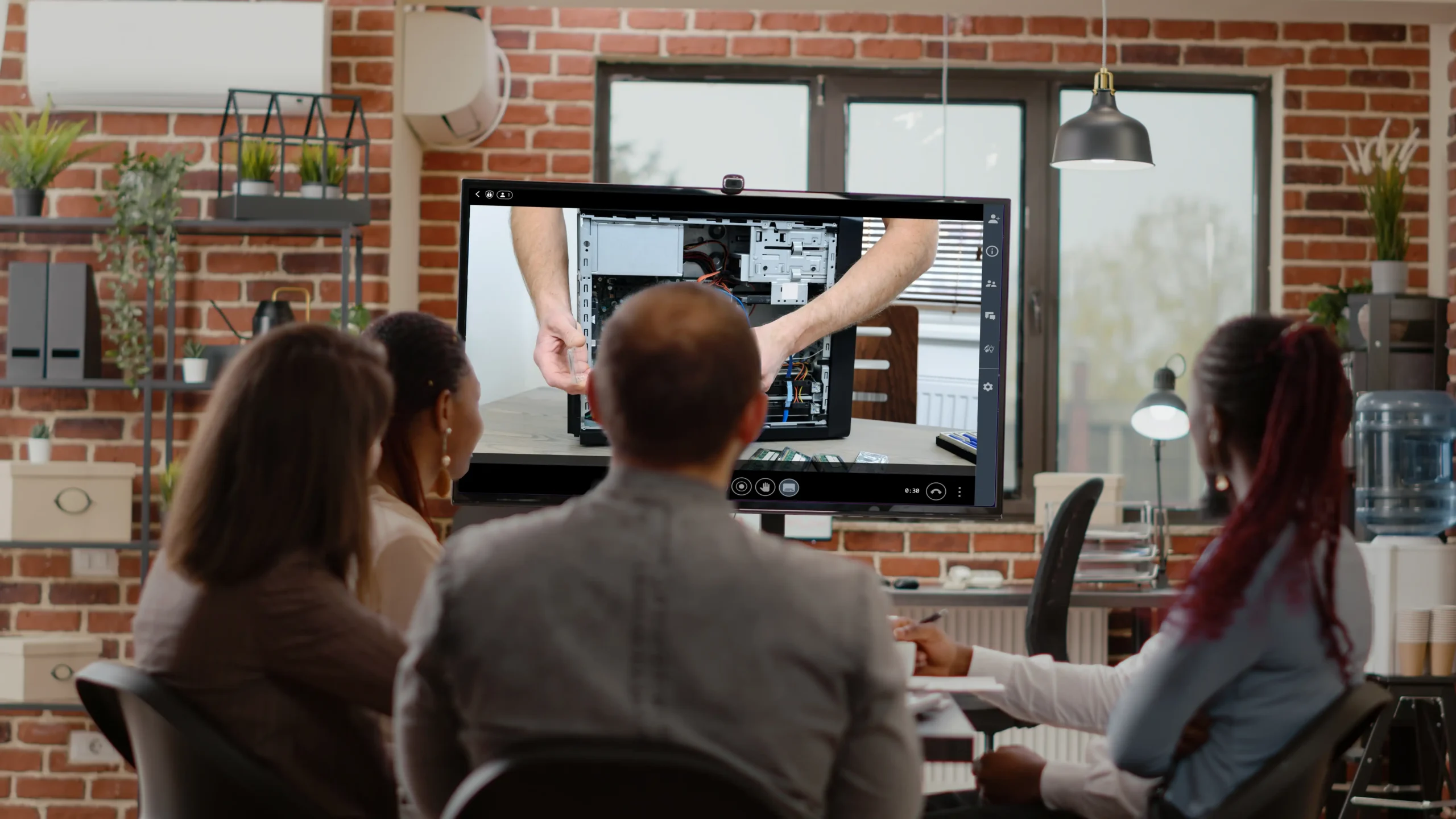As companies become more focused on efficiency, productivity and profitability, it has become essential that businesses look at their numbers to ensure that their time, money, and manpower are being put to good use — one of the biggest opportunities lies in assessing how business meetings are run.
We’ve all been in meetings that were run poorly, included the wrong people and didn’t lead to concrete objectives. By improving how meetings are run, businesses have a major way to immediately improve the way time is managed and how team members collaborate. Following best practices, using the right collaboration tools and holding everyone accountable can significantly improve your meeting experience.
What is a business meeting?
A business meeting is a gathering of two or more people for the purpose of making decisions or discussing company objectives and operations. Business meetings are generally conducted in person in an office, however with the rise of video conferencing technologies, participants can join a business meeting from anywhere.
Let’s take a look at the six most common types of business meetings, including:
- Status Update Meetings
- Decision-Making Meetings
- Problem-Solving Meetings
- Team-Building Meetings
- Idea-Sharing Meetings
- Innovation Meetings
6 Types of Business Meetings for Better Efficiency & Communication
Before planning meetings, it is necessary to identify what type of meeting it is. There is actually a huge difference between a weekly status meeting and an emergency meeting that might require urgent action.
1. Status Update Meetings
Almost every company is familiar with those recurring team meetings that were initially intended to share updates on the latest projects and make sure everyone on the team is on the same page about the process of the project. These meetings are meant to remedy any communication hiccups that may end up wasting significant amounts of time doing the same thing or facing the same challenges over and over.
While these types of meetings might not be the most fun or engaging, businesses use them to address any problems that have come up, assign tasks and make any decisions necessary to move forward effectively. Such meetings can turn into quick sync-ups and are less susceptible to dragging on past the given time frame.
2. Decision-Making Meetings
Although managers generally have the final say, the discussions around important business decisions often occur in larger groups. Smaller decisions may be made in status update meetings, but important ones will command their own dedicated meeting times.
The process of making a decision could be spread out over several different meetings so that all parties have a chance to gather information, come up with solutions and vote on how best to move forward. This can result in a lot of time tied up in meetings and communicating back and forth.
3. Problem-Solving Meetings
Similar to decision-making meetings, problem-solving meetings have a specific goal in mind. There’s no standard problem-solving meeting since issues vary depending on your team and your organization, but these types of meetings are crucial nonetheless.
These meetings may be based on emergencies that need to be resolved quickly. For example, the source of the problem may not be identified yet or there could be several different priorities to manage in finding a solution to an identified problem. Either way, these meetings give colleagues the chance to brainstorm, evaluate solutions and solve the problem at hand.
4. Team-Building Meetings
Although every meeting is a chance for a team to become a little closer by engaging in banter at the beginning and gaining a stronger understanding of their counterparts, sometimes it is necessary to have a planned team-building meeting.
These meetings can be corporate events or outings for the team, department or entire company and can serve to generate some employee loyalty and engagement. They are the perfect opportunity to encourage employees to mingle and create more personal relationships that can aid the progress and growth of the organization.
5. Idea-Sharing Meetings
Sometimes it’s better to have the whole group get together and share new ideas rather than distributing them in a meaty email or chaotic chat thread.
Not only do these meetings allow the speaker or presenter to go more in-depth on a topic, conversations can happen in real time and team members can ask questions. These meetings also make idea sharing interactive, giving colleagues the chance to bounce ideas off of one another, ultimately resulting in more teamwork, stronger relationship building and an engaging meeting experience. While this type of meeting can take up a great deal of time, it often results in new product ideas, expansion to new markets and ways to get ahead of the competition.
6. Innovation Meetings
Every organization needs new ideas from time to time, and innovation meetings are the standard answer to that need. It is difficult to force creativity, but you can solicit as many ideas as possible and then filter through them to find the most suitable ones.
Innovation meetings can sound obscure to attendees, but they are essential to making sure your company continues to move forward rather than retaining the same operating protocols year after year because they provide the organization a chance to try something new.
While it might feel unnecessary or obvious, defining the type of meeting you are having can guide the way your colleagues prepare for your meeting, help you establish a clear agenda and save everyone time. Here are a few tips on how to illuminate exactly what to do to turn your meetings into solid time investments.
3 Tips for Making the Best Use of your Meeting Time
With most managers agreeing that meetings tend to be an unproductive use of time and 65% of them saying that meetings prevent them from completing their own work, there needs to be a better way to meet more effectively. Here are three easy ways to get the most out of every meeting.
1. Set Clear Goals
Having a clear meeting agenda will help you minimize the amount of time the meeting takes. If you have tasks that attendees need to do beforehand, send out a checklist in your meeting invite to make sure everyone attending is aware and prepared. The basic goal here is to do everything in your power ahead of time to prevent an entire team’s time from being wasted.
The ideal meeting has no surprises and follows the agenda to a T. This could be a challenge since side conversations and tangents are pretty common in the conference room, so it’s important to keep those off-topic conversations short — you can always book another time to discuss further.
2. Run Through a Post-Meeting Recap
If you have a clear desired outcome, it is instantly clear when a meeting is a success. Afterward, managers can assess whether it achieved the desired outcome and figure out what would have made it more successful.
Sending out a quick recap of the meeting will boost the retention of information as well as clear up any miscommunications that might have occurred. You can also include any further action that your colleagues might need to take to reiterate the outcome of your meeting. Learn how to take effective meeting minutes to ensure you don’t miss any important details or takeaways from your meetings.
3. Use Dependable Video Conferencing Software
Productive business meetings don’t always have to be held in person — with the right video conferencing solution, you can still meet face to face and have a quality meeting experience without leaving your office space. If your video conferencing tool is intuitive enough, you’ll be able to share your screen, record your call and scale your meeting to guest callers across different devices seamlessly.
Completely dedicated to delivering the best video conferencing experience possible, Lifesize is the 4K quality and easy-to-use video conferencing solution you and your IT admin have been looking for. After more than fifteen years of developing conference room systems, wireless meeting room presentation devices, mobile apps and a global cloud network that ties it all together, Lifesize delivers an unmatched unified meeting experience that you can trust.
Keep All Meeting Types Efficient and Profitable
Meetings aren’t going away any time soon, but they don’t have to be so terrible! Just by defining what type of meeting you’d like to have and implementing these tips, you can keep your meetings productive and upbeat. Make the most of your meetings with Lifesize and experience what a great business meeting should be like.






